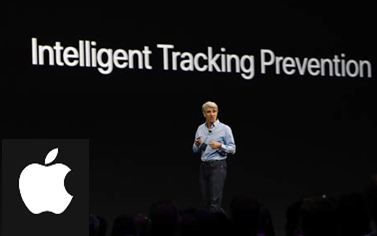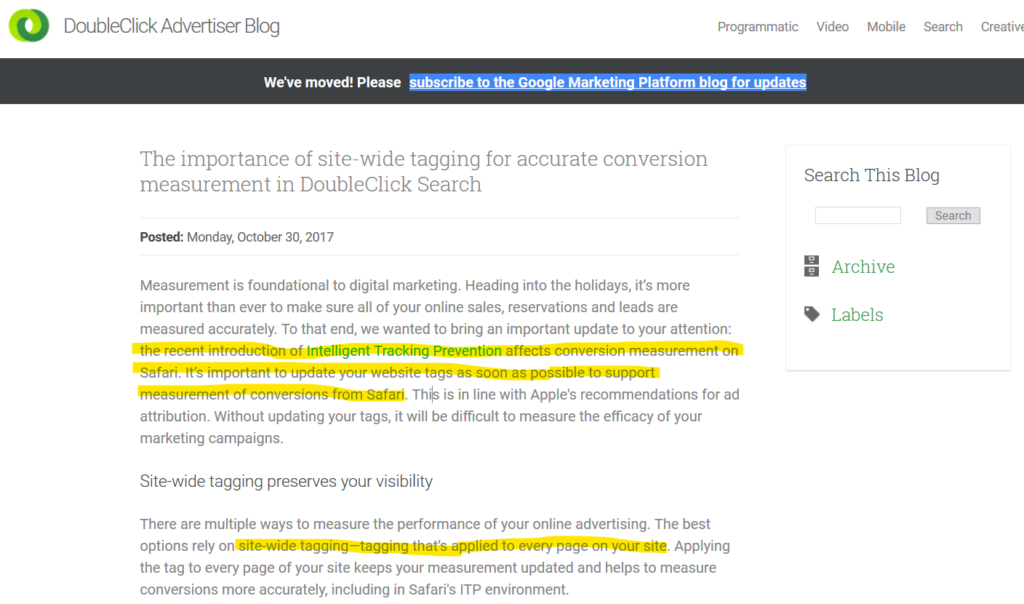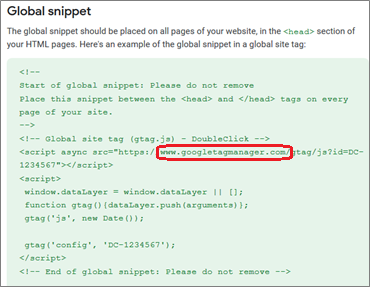3rd Post in a 6-Part Series About the Behavioral Data Land Grab
Big G and many of their media minions are quick to point out that by using the new global site tag, they can then get around ITP’s 3rd party tracking limitations. The reason is that the GTM tag architecture tricks the user’s Web browser to treating it as 1st party by changing the context. The legacy DFA Floodlight tag cannot do this as it is a plain and simple 3rd party tracker in a 3rd party context. That DoubleClick impression cookie served up on ad delivery (on media publisher site) and then later checked for by the DFA Floodlight (on the advertisers site) is notorious enough at this point to be easily black-listed by blockers and anti-virus platforms.

Manufactured Crisis?
The global site tag (gtag.js) request often comes from the media agency team as a panicked rush to install the new code snippet – toute suite. The implication is that if these new global site tags are *not* used, then campaign measurement and therefore campaign performance will dramatically suffer or to become questionable. The implied benefit of the new global site tag is that at minimum, current paid search measurement accuracy will be better. What this really means is that Big G AdWords conversions (clickthough and (post-clickthrough) can be more accurately counted.

Most advertisers and their agencies will miss the nuance. They may not realize that simply showing more conversions in AdWords reports does not mean that Big G paid search actually caused more of them to happen. Questionable incrementality is a broader problem with paid search attribution and Big G’s walled garden of search performance data. That aside, showing the universe of conversions that an advertiser is already receiving more accurately only means that Big G’s AdWords reporting approaches the conversion tracking accuracy of site analytics like Adobe’s. Stated differently, Big G fixed their conversion tracking problem (caused by 3rd party blocking by ITP, plug-ins and anti-virus deleters) which before the global site tag relied on a predicted count. That is what has been reported out for years in AdWords. It is all about Big G more confidently taking greater credit for more of the conversions in their analytics system (not advertisers’).
Dropping the Ball: Who Do They Work for Anyway?
Instead of pushing back to Big G on behalf of their clients or suggesting alternative solutions, too many media agencies are not doing their diligence. They are pressuring clients to just go along with the request and merely parroting that Big G recommends this without much question. The implication is that the global site tag is needed for the media agency to measure better and there fore to do their very job. At the same time, most digital advertisers today do not want to provide their media agency with another reason for bad analytics and poor measurement. Meanwhile Apple ITP is conveniently blamed for the problem.

Expected to be stewards of their client’s digital media business, this is an unabashed agency fail. All told, the new global tag combined with an expanded tag footprint on the Web site is a shifty way for Big G to also ingest more highly valuable behavioral data at the expense of digital advertisers. Even more unseemly is that this is a clever end-run to thwart advertisers that sought to limit Big G’s behavioral data access by not using their Analytics/Tag Manager products in the first place. Worse, the end result is dysfunction with analytics teams and hidden operational costs of a maintaining a redundant de facto tag management system.
Such conduct by those representing themselves as agents of marketers is disappointing. Unfortunately, it is consistent with the unflattering issues of undisclosed incentives and rebates from tech companies, media vendors and others that was revealed in the ANA Media Transparency Report of 2015. Digital advertiser clients themselves are not blameless: the buck needs to stop with them.









